Your practice sessions are where you make progress as a guitarist. The better quality practice you can have, the faster you will learn.
This guide will explain why your practice space is important and how to set up an effective practice space.
After reading this guide, read this guide on how to plan your guitar practice routine. Follow the steps to plan a practice routine that perfectly matches your goals as a guitarist.
If you want to hang your guitar on the wall, check out this Ultimate DIY Guide to Hanging Guitars on Walls.
Why You Need a Guitar Practice Space
It shouldn’t be any surprise that the more you practice, the better you’ll get at guitar. One of the easiest ways you can make sure you practice more often is to set up a dedicated practice space where you can easily jump right in.
As an example let’s say you keep your guitar locked in a hard case under your bed. It’s nice and safe there, but from a practicing point of view, it’s in the worst possible place. To practice, you need to take the case out from under your bed, open it, take the guitar out, collect any practice materials such as sheet music and take all of it to somewhere you can practice.
Because it takes so much effort to get started, you’re less likely to practice when you’re not 100% motivated. If you had the choice between practicing or watching videos on YouTube, you’re probably going to go the easy option with YouTube rather than put the effort into getting your guitar and materials ready.
While that’s an extreme example, it shows how easily we’re influenced by our practice space. A poorly set up practice space (or none at all) reduces how often you practice whether you realize it or not.
When you have a good practice space set up, you’re likely to practice more often. This guide is about being smarter with practice rather than working harder.
If you want to squeeze more practice into your day, read through this guide on How to Practice Guitar Without a Guitar. The guide will explain how you can develop your skills while on vacation, driving, or any time you have a few minutes spare.
Note: skip ahead past the recommended equipment to see examples of practice spaces.
Where to Set Up Your Guitar Practice Space
There are two options I recommend for your practice space. The right option for you depends on which is more practical and which you’re more likely to use:
Private room
Practicing in a distraction-free environment is crucial to getting the most out of your practice sessions. If you’re distracted by other people in your home or a loud TV, you’re going to have a hard time focusing on your practice (even if you want to play guitar using headphones).
For this reason, it’s a good idea to set up your practice space in a separate room that will be private and quiet. For some people, this will be your bedroom while other people may have the luxury of a dedicated music room or study.
Having a private room will also help you avoid disturbing others when you practice. If you get noise complaints, find out how to practice guitar quietly in this guide.
Common room
There are times when it makes sense to set up your practice space in a common living area like a lounge room. While you might not have as much privacy as a dedicated practice room, there’s a different reason why it can be effective.
If you spend most of your time at home in a common living area, then having your practice space in that same area means you’re far more likely to pick up a guitar and practice. Instead of reminding yourself to go to a different room and practice, if you can simply reach over and pick up your guitar, you’re going to get more practice time in. It might not be as good as a dedicated practice room, but if it means you pick up your guitar more often, it’s effective.
Have a think about how often you practice now and whether having your practice space in a dedicated room or a common living area (or both if you can) would result in more practice. If one doesn’t work for you, try the other.
Practice Space Essentials
The best guitar practice spaces have all the essential tools, gear, and materials all ready to go within reach. If you need to search around to find a tuner or dig around a pile of cables to set up your rig every time you need to practice, you’re not going to get much practice done.
Make sure your practice space has everything you need all ready to go so when you want to practice you can simply sit down, pick up your guitar, flick a switch if you play electric guitar and you’re good to go.
Here are some essential tools and gear to have in your practice space:
Metronome/Drum Machine
A metronome is a crucial skill development tool. If you don’t already have one, get one like this Korg digital metronome and tuner:
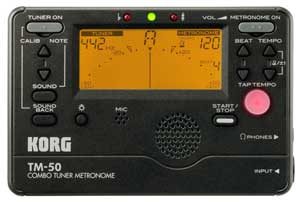
Alternatively, you can use a smartphone or tablet and get a metronome app – just make sure you read the warning about using a smartphone covered later.
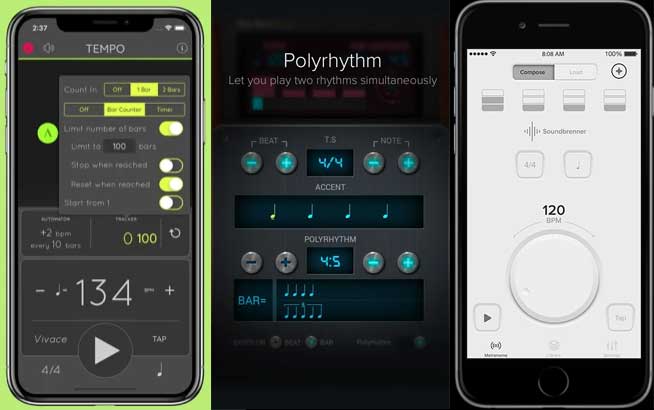
There are a lot of free or paid metronome apps that can subdivide rhythms and other useful features that can help you get more out of your practice sessions.
Tuner
Practicing an in-tune guitar is important as it affects your ear skills. You want to train your ears to hear an in-tune guitar rather than get used to an out-of-tune guitar. If you’re a beginner it might not seem that important if the guitar is slightly out-of-tune, but advanced guitarists know how important it is to practice on a properly tuned guitar.
If you play acoustic guitar, you can use a tuner like the metronome/tuner combo above, or a clip-on tuner like the TC Electronic PolyClip:
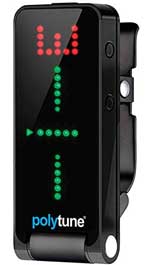
If you play electric guitar you can use either of the above two options, but I highly recommend a dedicated guitar tuner pedal like the TC Electronic PolyTune 3:

If you’re after other suggestions, check out my guide on guitar tuners here.
Music Stand
While you can use a desk or table to sit any sheet music or learning materials, do yourself a favor and get a music stand. You have better posture when playing which prevents strains or bad habits and it just makes everything easier.
I highly recommend a solid music stand like this one as shown below instead of a flimsy wireframe-style stand. You can’t rest a smartphone or small items on those wireframe stands.
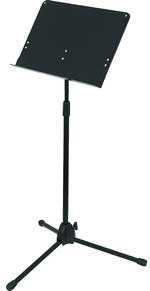
Smartphone/Tablet
A smartphone or tablet can be a fantastic tool to have in your practice space or it can be a horrible distraction. It depends on how you use it.
There are a lot of useful apps that can enhance your practice sessions. From simple tuner and metronome apps, to TAB playback, recording, or jamming, you can do a lot of productive things with a smartphone.
If you can resist the urge to check social media, you’re not going to get any messages or calls or any other notifications while you practice, then having your smartphone with you is a handy way to access useful apps that enhance your practice session. Put it on airplane mode and only use apps that will be useful to your practice.
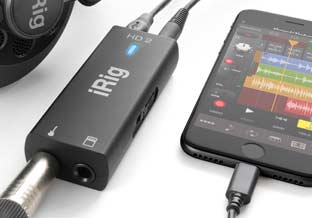
Even one notification sound can be enough to throw your focus off and ruin a practice session. If your phone is going to be a distraction from your practice, put it on silent and keep it in a completely different room while you’re practicing.
Just like people at the gym spending half their time taking selfies, if you spend time on your phone – you’re not practicing.
Complete guitar rig set up and ready to go
If you play acoustic guitar all you need is your guitar on a stand and you’re good to go. If you play electric, it’s a bit more complicated.
Your rig needs to be set up and so easy to get started that all you need to do is flick a switch and pick up your guitar. My old practice space wasn’t in an ideal situation which meant any time I wanted to practice I had to reach behind a cabinet to flick the power switch to my pedalboard, turn on my amp, go and pick up my guitar from the other side of the room and plug it in. Bad.
My new practice space all I need to do is flick a little switch on the wall next to my amp (arm’s reach from my chair) and pick up my guitar. Everything is already plugged in and ready to go. Much better.
Comfy chair
Comfort is important if you’re going to be spending a lot of time practicing. Make sure you have a suitable chair that you’re happy to sit in while practicing. For example, my old desk chair had arms – not ideal for playing guitar.
At the other extreme, a couch would be comfy, but probably not a good idea for practicing in. You’re going to end up with bad posture which can cause problems over time.
A way to record yourself
Being able to easily record yourself at any point in your practice session is such a valuable way to capture new ideas or record your progress.
You could use a smartphone app, a PC/Mac with a microphone or audio interface or even a looper pedal.
I use a WireTap by TC Electronic (link to my full review) which is already connected to my rig so all I need to do is tap the footswitch and I’m instantly recording. Highly recommended for all guitarists.
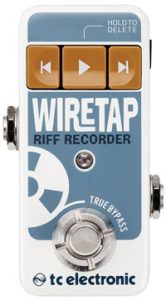
Examples of Guitar Practice Spaces
Let’s have a look at some examples of different guitar practice spaces. You might get some ideas you can take away and use in your practice space so read through my thoughts on each one.
Note: most of these probably weren’t set up as dedicated practice spaces, but let’s look at whether they’re suitable or not.
Guitar Practice Space Example 1
If you have limited space, it can make it difficult to set up an effective practice space. Have a look at this small area and think about what you would change or keep.
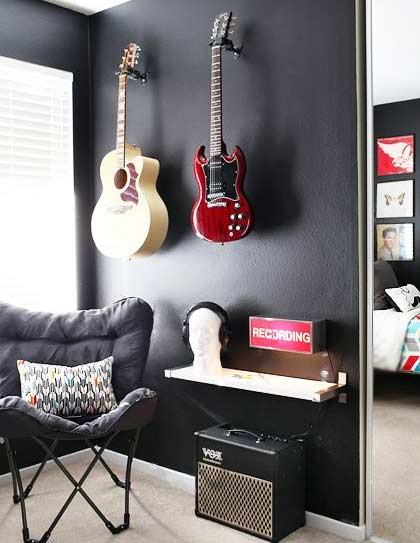
Good points:
- Hanging guitars on the wall frees up floor space for your amp or pedalboard
- The head is a nice way to store headphones
- Having wall mounted shelves is a good option for small rooms or for storing useful items within reach of a chair
- Simple rig means easy to get started
If you want to hang your guitar on the wall, check out this Ultimate DIY Guide to Hanging Guitars on Walls.
Bad points:
- The chair is not suitable for practicing
- No music stand or place to work with sheet music, apps, or any other resources
Guitar Practice Space Example 2
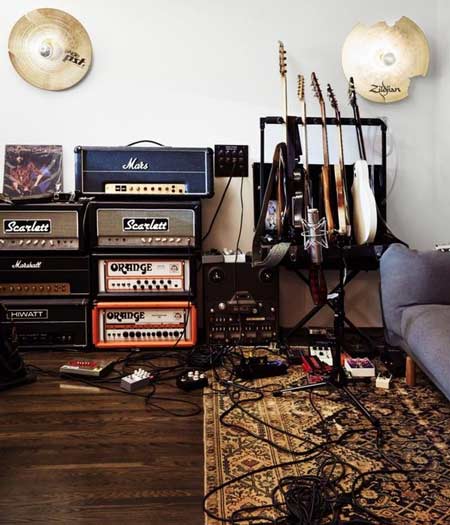
Good points:
- Guitars all stored nicely in a rack which doesn’t take up much space but are easily accessible
Bad points:
- The floor is a mess with cables and pedals scattered around
- The couch might be fine for random jamming, but far from ideal for serious practice
- No music stand or table for learning materials and tools
Guitar Practice Space Example 3
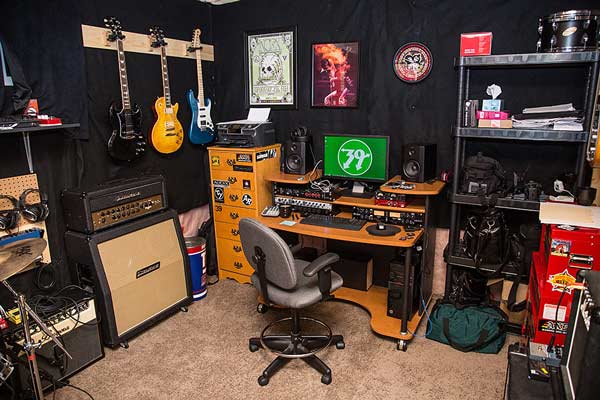
Good points:
- All gear nicely stored against the wall which gives plenty of space to move around
- Almost everything is within reach of the chair
- Computer with useful gear available and ready to use
Bad points:
- Chairs with arms aren’t ideal as they get in the way (chairs like this one usually allow you to remove the armrests)
- Lots of pedals on shelves and no pedalboard means the pedals aren’t instantly accessible
- The amp isn’t plugged in and ready to go
- The more complicated a setup is, the less likely it will be used (eg: lots of rack gear)
Guitar Practice Space Example 4
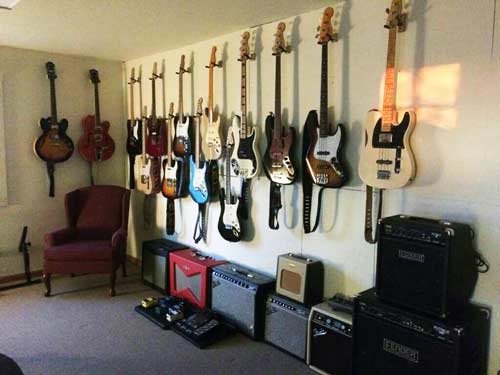
Good points:
- Good storage of a lot of guitars frees up floor space
- The range of different guitars/basses means easy switching to practice different styles/tunings/skills
- Neat pedalboard set up
- Having straps on all the guitars means you can easily pick up any one and start practicing
Bad points:
- The chair isn’t suitable (although it looks like this guitarist prefers to stand)
- No table/shelf/stand for useful materials or tools
- It doesn’t look like any of the amps or the pedalboard are plugged in. Nor is there a cable ready to go
Guitar Practice Space Example 5
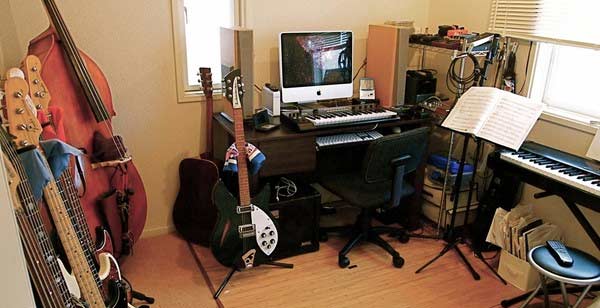
Good points:
- Music stand, guitar, keyboard and computer all within arm’s reach
- Suitable chair
Bad points:
- Looks a bit cramped. Moving non-essentials out of the room or into shelving would be a good idea
- Why is the pedalboard sitting on top of the storage shelf? It’s not going to get any use up there
Guitar Practice Space Example 6

Good points:
- Acoustic guitar, keyboard, and computer all within arm’s reach
- Plenty of desk space for any learning materials
Bad points:
- Electric guitar out of reach behind the keyboard means it won’t get much use
- Terrible chair for an acoustic guitar
- Having a stand for the acoustic guitar is much better than resting it against the desk
- Where’s the amp to practice the electric guitar?
Guitar Practice Space Example 7
This practice space is a great example that may suit a guitarist who regularly performs live. Setting up an area where you can replicate your live setup is worth thinking about.
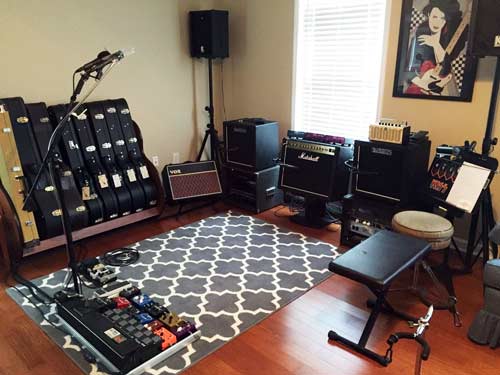
Good points:
- Everything set up neatly and ready to go (except guitars)
- Stool next to the music stand
- Standing area with pedalboard and microphone in ideal position
- Speaker system on stands in good position
Bad points:
- Guitars in cases don’t get played
- A music stand next to the microphone stand would be handy for taking notes
Key Lessons for Your Practice Space
- Use a suitable chair
- Have everything you need within arm’s reach (if possible)
- Make it as easy as possible to sit down and start practicing
- The more steps involved in starting your practice session, the less likely you will actually start practicing
- Have your rig set up and ready to go at a flick of a switch
- Have a guitar within arm’s reach from where you spend your most time at home
- Keep any potential distractions away from your practice space (eg: phone, TV, games console, etc.)
If you want to hang your guitar on the wall, check out this Ultimate DIY Guide to Hanging Guitars on Walls.
For regular practice tips and ideas, subscribe for email updates.
Once you have your practice space set up, find out how long to practice guitar per day in this guide. You’ll develop your guitar skills at a faster rate if you follow the advice in that guide.

